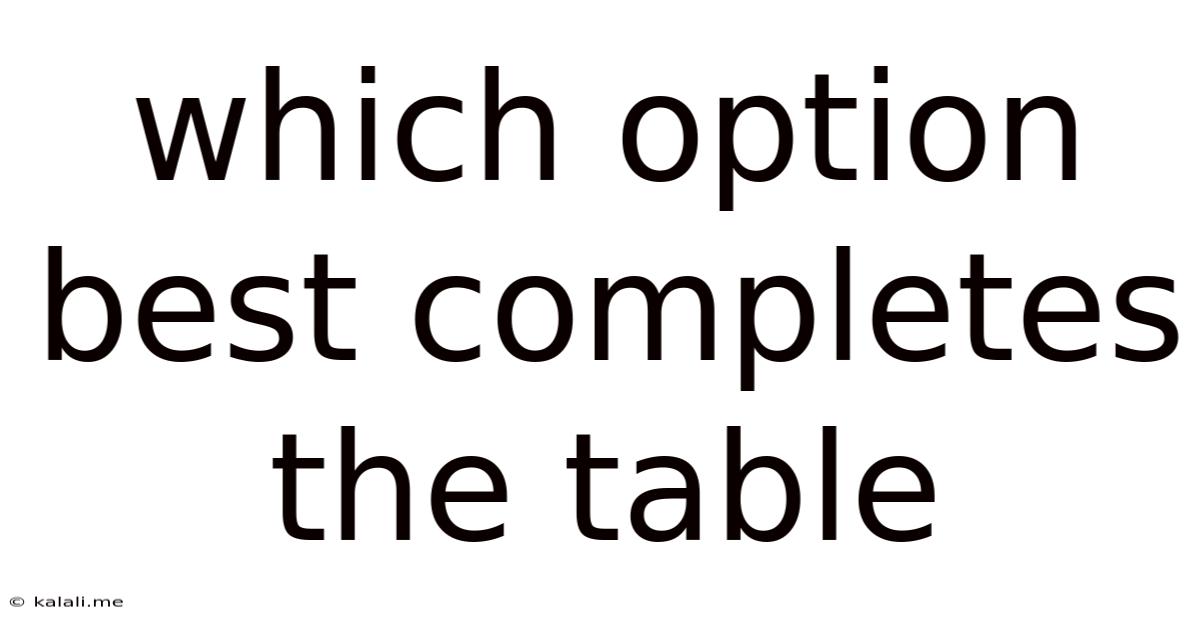Which Option Best Completes The Table
Kalali
Jun 11, 2025 · 3 min read

Table of Contents
Which Option Best Completes the Table? A Guide to Choosing the Right Answer
Choosing the best option to complete a table might seem simple, but it requires careful analysis and understanding of the underlying patterns and relationships within the data. This article will equip you with strategies to effectively tackle this common question type, whether it appears in a quiz, test, or real-world data analysis scenario. This guide covers various table completion scenarios, from simple number sequences to more complex logical reasoning puzzles.
Understanding Table Completion Questions
Table completion questions assess your ability to identify patterns, deduce missing information, and apply logical reasoning. They often involve numerical sequences, alphabetical patterns, or more complex relationships between data points. The key is to systematically analyze the provided information to discover the underlying rule or principle governing the table.
Strategies for Solving Table Completion Questions
Here's a breakdown of strategies to help you find the correct answer:
1. Identify the Pattern:
- Numerical Sequences: Look for arithmetic progressions (constant differences between numbers), geometric progressions (constant ratios between numbers), or more complex patterns. Consider differences between consecutive numbers, sums, or products.
- Alphabetical Patterns: Analyze letter sequences for alphabetical order, reversals, skips, or combinations of these patterns.
- Logical Relationships: If the table involves categories or concepts, determine the relationships between the different items. Think about categorization, hierarchies, or cause-and-effect relationships.
2. Test Your Hypotheses:
Once you've identified a potential pattern, test it rigorously. Does it consistently apply to all the completed parts of the table? If not, re-evaluate your assumptions and look for alternative patterns.
3. Consider Multiple Dimensions:
Sometimes, the pattern isn't simply a single sequence but involves relationships between rows, columns, or diagonals. Look for patterns across multiple dimensions of the table to uncover hidden connections.
4. Eliminate Incorrect Options:
Use the process of elimination to narrow down your choices. If an option doesn't fit the established pattern, eliminate it. This process increases your chances of selecting the correct answer.
5. Visualize the Data (if applicable):
For numerical data, consider creating a graph or chart to visualize the relationships between data points. This can often reveal hidden patterns that are difficult to spot in a table format.
Example Scenarios and Solutions
Let's illustrate these strategies with a couple of examples:
Example 1: Numerical Sequence
| Column A | Column B |
|---|---|
| 2 | 4 |
| 4 | 8 |
| 6 | ? |
Solution: The pattern is simple: Column B is double the value of Column A. Therefore, the missing value is 12.
Example 2: More Complex Pattern
| Row | Column 1 | Column 2 | Column 3 |
|---|---|---|---|
| 1 | A | B | C |
| 2 | D | E | F |
| 3 | G | ? | I |
Solution: The pattern is alphabetical order, progressing down the columns. Therefore, the missing value is H.
Conclusion
Mastering table completion questions requires a combination of pattern recognition, logical reasoning, and systematic analysis. By employing these strategies, you can effectively identify the underlying rules governing the data and confidently choose the option that best completes the table. Remember to always test your hypothesis and eliminate incorrect options to arrive at the correct solution. Practice is key to improving your ability to solve these types of questions efficiently and accurately.
Latest Posts
Latest Posts
-
How Many Guppies In A 5 Gallon Tank
Jul 01, 2025
-
How To Beat Stage 7 In Bloxorz
Jul 01, 2025
-
How Much Oz In A Bottle Of Water
Jul 01, 2025
-
How Long Does It Take To Drive 10 Miles
Jul 01, 2025
-
How Many 9s Are In A Deck Of Cards
Jul 01, 2025
Related Post
Thank you for visiting our website which covers about Which Option Best Completes The Table . We hope the information provided has been useful to you. Feel free to contact us if you have any questions or need further assistance. See you next time and don't miss to bookmark.